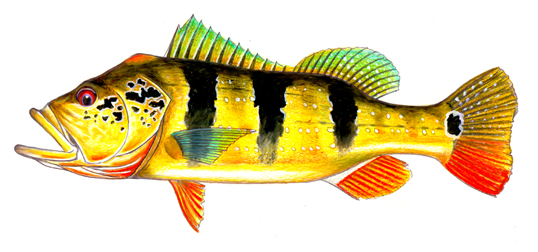Peacockbass

Popular Name: Tucunaré (tucunaré-açu/paca, tucunarépinima; tucunaré-vermelho)
Scientific Name: Cichla spp.
Family: Cichlidae
Record Weight: Cichla temensis - Tucunaré-açu - 12,24kg/27lb.
Amazon basins and Tocantins-Araguaia; introduced in reservoirs of the Paraná Basin, Pantanal, San Francisco and dams in the Northeast.
DESCRIPTIONFish scales; elongated body and a little long. There are at least 15 species described: The size (can measure 30cm to over 1m in total length), the color (can be yellow, green, red, blue, almost black) and the shape and number of spots (can be great black and vertical, or white spots evenly spread throughout the body and fins) vary greatly from species to species. All tucunarés have an eyespot on the caudal peduncle.
ECOLOGYThey have diurnal habits; They do not perform migration: living in lakes / ponds in flooded forest and in the mouth and backwater rivers. They form couples, build nests and care for the offspring. They feed on fish and shrimp. After starting an attack, do not give up until you capture prey, so they are highly appreciated by sports fishermen. Almost all other predatory fish drop out after the first or second attempt failed. All species are important commercially. The largest peacock bass, peacock bass, or paca açu Cichla temensis occur in rivers of black water.
EQUIPMENTSBait Casting: Medium Heavy action rods 5'6 to 6' for 20~25 lbs line, reels or spinning reels that comport 100 yards of the selected line, witch should be 0,40~0,45mm monofilament Line (20lbs) or braided line (multifilament) PE4 ~ PE6 (0,30~0,35mm), Fluor Shock leader 40~60lbs, reinforced snaps 30~50lbs (tested).
LURESFish, shrimp and artificial lures. Virtually all types of artificial baits can attract peacock bass, but the surface of plug fishing is the most exciting. The peacock bass explode on the surface of water attacking the bait.
TIPSMove the artificial bait, because the peacock bass can attack from 4 to 5 times before being hooked.

